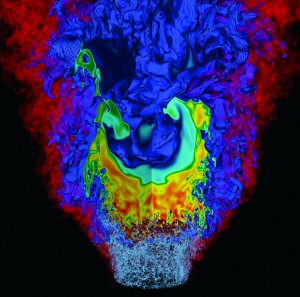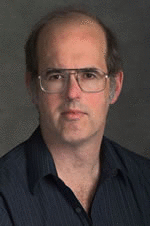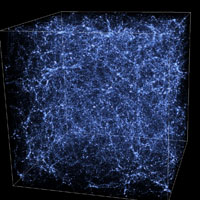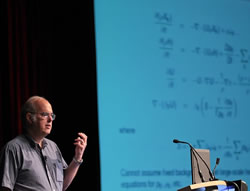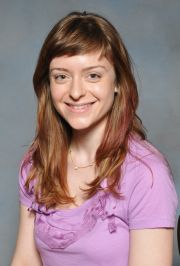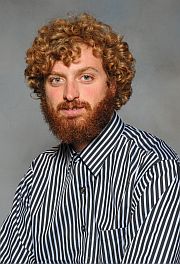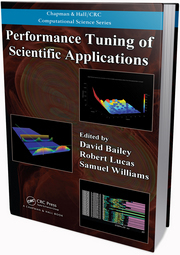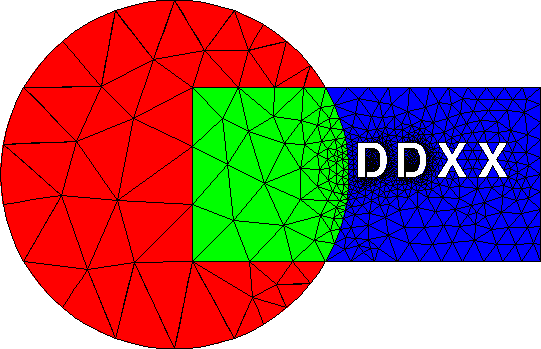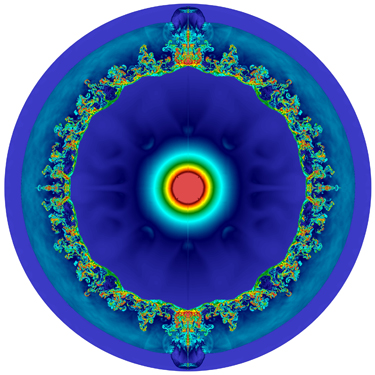
 We are currently taking applications for postdocs.
Click the following links to apply: We are currently taking applications for postdocs.
Click the following links to apply:
Job ID:
73943
73945
|
December 2011 News
|
|
The new Combustion Exascale Co-Design Center, led by Jackie Chen of Sandia as Director and Combution Lead, and
John Bell
of CCSE as Deputy Director and Math Lead, was featured in a recent CRD highlight written
by LBL's Jon Bashor. The article, titled
"Co-Designing Exascale Architectures and Algorithms for Real-World Combustion Simulations"
is available
here.
|
November 2011 News
2012 INCITE Awards -- CCSE and Collaborators Awarded 86 Million Hours
The DOE Office of Science has announced awards
of nearly 1.7 billion supercomputing hours via the
INCITE
program to 60 high-impact research projects which will address scientific and engineering challenges
of national and global importance. CCSE and collaborators earned 86 million of those hours.
The first award, titled "Simulation of Turbulent Lean Hydrogen Flames in High Pressure", with PI
John Bell and Co-I
Marc Day,
was for 40 million hours. The second award, titled "Petascale Simulations of Type Ia Supernovae,"
with PI Stan Woosley of UCSC and Co-I's John Bell, Mike Zingale of Stony Brook University, and Dan Kasen of UC Berkeley,
was for 46 million hours. The average allocation was 28 million hours. Click
here
for a link to the Fact Sheets on all 60 awards.
|
|
|
|
Nonaka Presents at Albany High School Career Day
Andy Nonaka
is an invited speaker at the Albany High School Career Day on Wednesday, November 16. His talk,
``Putting Math and Science to Work,'' is designed to engage students in thinking about
possible future careers in the world of math, science and computers, or any combination of the three.
|
Bell Presents Campus Seminar on Finite Volume Methods for Fluctuating Hydrodynamics
John Bell
gave the applied math seminar at UC Berkeley on November 9, discussing
recent work on finite volume methods for fluctuating hydrodynamics. Part of abstract follows:
"At small scales, the Navier-Stokes equations traditionally used for modeling fluid flow break down
and thermal fluctuations play an important role in the dynamics. Landau and Lifshitz proposed a modified
version of the Navier-Stokes equations, referred to as the fluctuating Navier-Stokes equations (FNS),
that adds stochastic flux terms designed to incorporate the effect of fluctuations. These stochastic fluxes
are constructed so that the FNS equations are consistent with equilibrium fluctuations from statistical
mechanics. Here we describe the development and analysis of finite-volume methods for PDEs with
stochastic flux terms...."
|
|
|
|
Nyx Simulation Featured at SC11
A recent
Nyx
simulation of the evolution of the expanding universe will be featured as a live demonstration
in the SC11 Exhibit Hall in Seattle, Washington, November 12-16. The simulation was
performed on 4K cores on the hopper machine at NERSC. The demonstration,
titled Visualizing the Universe at 100 Gbps, will take place in the Berkeley Lab Booth.
Additional simulations using CCSE codes area also featured in the Berkeley Lab Booth include
Buoyant Burning Bubbles in Type Ia Supernovae,
Turbulent Jets with Off-Source Heating
(IAMR), and
A New Perspective on Supernova Explosions.
(CASTRO).
More information about the LBL Demonstrations at SC11 can be found
here.
|
October 2011 News
BoxLib Now Available for Easy Download
BoxLib, CCSE's block-structured AMR framework, on which many of its codes are built, is now available
by easy download here .
BoxLib forms the foundation for
MAESTRO,
CASTRO,
Nyx,
and many other codes used by CCSE and its many collaborators.
More information about BoxLib is available here .
|
|
|
Bell Announced As Department Head of Mathematics and Computational Science Dept.
David Brown, the head of the Computational Research Division (CRD), recently announced the formation
of three new departments within CRD.
John Bell will head the new Mathematics and Computational
Science Department, which consists of the
Mathematics Group,
CCSE,
and the
Computational Cosmology Center (C3).
The new Applied Mathematics and Scientific Computing Group will be led by Esmond Ng, and is composed of the
Scientific Computing Group,
the Complex Systems Group, and the
Applied Numerical Algorithms Group.
Finally, John Shalf will head the new Computer and Data Sciences Department, that encompasses the
Visualization,
Scientific Data Management,
Future Technologies
and Advanced Technologies Groups.
See the full announcement
here.
|
September 2011 News
Robert Cheng and John Bell Featured on KQED's QUEST TV show
``Fire is one of humankind's first technologies. We have been staring into the proverbial campfire for thousands of years.
Yet, surprisingly there seems to be much more to learn. And now it's becoming even more important to our collective
future that we know as much as we can about fire... ''
`` Robert Cheng,
John Bell
and the other team members have come together from different scientific disciplines;
from mechanical engineering and mathematics to physics and chemistry, to develop these
innovative burners
and
amazing three-dimensional combustion simulations
that take advantage of some of the largest super computers in the world.
The results are incredibly beautiful and mesmerizing models that one can get lost in staring at...''
This is the opening of the TV segment on KQED's QUEST Science show, which will air 7:30pm PST on Wednesday, Sept. 28, 2011.
The clip of Robert Cheng of EETD and John Bell, head of CCSE, is featured
here.
|
|
|
|
DOE recently announced the award of the Combustion Exascale Co-Design
Center (CECDC) at the July SciDAC Meeting in Denver. The CECDC is
led by Jackie Chen of Sandia as Director and Combution Lead, and
John Bell
of CCSE as Deputy Director and Math Lead. A kick-off meeting for the
CECDC was held Sept 20-22 at Sandia in Livermore.
Marc Day,
Vince Beckner, and
Mike Lijewski
of CCSE are also part of the new CECDC.
|
Bell Co-Organizer of DOE Applied Math Workshop
John Bell
and David Brown of LBNL, as well as Mihai Anitescu (Argonne National Lab),
Michael Ferris (Univ. of Wisconsin), and Robert Moser (Univ. of Texas, Austin),
organized the recent
DOE Applied Math Workshop on "Mathematics for the Analysis, Simulation, and
Optimization of Complex Systems" that was held
Sept 13-14, 2011. The goal of this workshop was to identify new research areas in
applied mathematics that will complement and enhance the existing DOE ASCR Applied Mathematics Program efforts
that address the understanding of complex systems.
The report that will result from this workshop will be a valuable resource for
defining the potential impact of research in applied mathematics
on problems important to the mission of DOE. Details of the workshop can be found
here.
|
|
August 2011 News
July 2011 News
|
|
Balakrishnan Gives Two Presentations at ICDERS Meeting
CCSE Postdoc
Kaushik Balakrishnan,
gave two presentations at this year's ICDERS Meeting,
held at the Univeristy of California, Irvine, July 24-29. This meeting is the
23rd International Colloquium on the Dynamics of Explosions and Reactive Systems (ICDERS)
The first presentation, titled
Ignition of Aluminum Particle Clouds Behind Reflected Shock Waves, was co-authored by
Balakrishnan,
Allen Kuhl of LLNL,
John Bell. and
Vince Beckner.
His second presentation, similarly authored, was titled
An Empirical Model for the Ignition of Aluminum Particle Clouds Behind Blast Waves.
A third paper, authored by Kuhl, Bell, Beckner and Balakrishnan, was presented by Allen Kuhl.
|
These three papers discuss research focused on adaptive, numerical simulations to understand the
dispersion and ignition behavior of aluminum particle clouds behind reflected shock and blast waves.
Of particular interest is investigation of the ignition/combustion behavior of reactive particle clouds
for a various suite of identified parameters using a novel empirical ignition model.
In addition, turbulent mixing in an explosive fireball, and the dissociation of air behind
blast waves, are quantified using the Implicit Large Eddy Simulation (ILES) strategy.
Bell Gives Invited Lecture at 2011 ICIAM Meeting
One of the highlighted speakers at this year's ICIAM conference, held in Vancouver, was
John Bell.
Bell spoke on Wednesday, July 20 about his joint work with collaborators
Andy Nonaka
and
Ann Almgren
of CCSE, and
Mike Zingale
of Stony Brook University,
on Low Mach Number Models in Computational Astrophysics.
|
|
According to the July 20 update of ICIAM Today,
" In the invited lecture, Low Mach Number Models in Computational Astrophysics, John B. Bell
(Lawrence Berkeley National Laboratory) described several astrophysical problems that are
characterized by low Mach number flows, such as convection phase in a white dwarf prior to
ignition of Type Ia supernovae, X-ray bursts and convection in massive stars. Discussing the
derivation of low Mach number models for astrophysical applications, he illustrated
computational results demonstrating applications of the methodology."
|
|
Almgren and Nonaka contribute to 2011 UC-HIPACC International Summer School on AstroComputing
Ann Almgren
and
Andy Nonaka
are two of the speakers at this year's
2011 UC-HIPACC Summer School on Computational Explosive Astrophysics, held July 18-29 at
LBL and UC Berkeley. Over 25 students from universities across the country come together
for two weeks to learn the basics of how to compute explosive phenomena in our universe.
Talks and workshops cover such topics as numerical hydrodynamics, self-gravity,
equation of state (EOS) and reaction networks, flame models, Adaptive Mesh Refinement (AMR),
and visualization of computational results. The first week will focus
on Type Ia supernovae, while the second week will cover core collapse supernovae,
gamma ray bursts (GRBs), and radiation transport.
|
CSGF Fellows Present at 2011 DOE CSGF Annual Conference
CSGF Fellows
Leslie Dewan,
Chris Eldred,
and
Thomas Fai
will be presenting their work at the
2011 DOE CSGF Annual Conference
held July 21-23 in Washington, D.C. Chris' poster will discuss the
WRF model configuration for seasonal climate forecasting over the Bolivian altiplano; Thomas will present his work on
An FFT-based immersed boundary method for variable viscosity and density fluids, and Leslie's poster will cover her work on
Quantifying radiation damage to the network structure of radioactive waste-bearing materials.
|
|
|
|
Almgren presents poster at 2011 SciDAC Meeting
Ann Almgren
presented a poster titled
From Convection to Explosion: End-to-End Simulation of Type Ia Supernovae at this year's
SciDAC Meeting, held July 10-15 in Denver, Colorado. The accompanying paper can be found
here.
|
von Neumann Symposium organized by Bell, Garcia and Alexander a Huge Success
The
2011 von Neumann Symposium on Multimodel and Multialgorithm Coupling
for Multiscale Problems, held July 4-7 in Snowbird, Utah,
and organized by
John Bell (chair),
Alejandro Garcia
of San Jose State University,
and Frank Alexander of Los Alamos National Laboratory, was widely viewed to be
a huge success. The von Neumann symposium is sponsored by the American Mathematical
Society (AMS). Participants from all over the U.S. and abroad came to Snowbird
for four days of talks and discussion about multiscale, multimodel and multialgorithm
issues. CSGF summer students
Thomas Fai
and
Chris Eldred
joined Bell at the meeting.
|
|
June 2011 News
Three CSGF Fellows Join CCSE for Summer 2011
DOE's Computational Science Graduate Fellowship program requires that its fellows spend
at least one summer at a national laboratory during their fellowship period. Three CSGF
fellows have joined CCSE for summer 2011.
Leslie Dewan is a student at MIT studying Nuclear Waste Management. She will work
with CCSE on numerical simulation of porous media.
Chris Eldred is a student at the University of Utah studying Climate Modeling.
He will work with CCSE on stochastic modeling.
Finally,
Thomas Fai
is a student at New York University studying Applied Mathematics.
He will work with CCSE on fluctuating hydrodynamics.
|
|
May 2011 News
|
|
Fagnan Speaks at Cray User's Group Meeting
Kirsten Fagnan
gave a talk at the
2011 Cray User's Group Meeting
held May 23-26 in Fairbanks, Alaska on
"Acceleration of Porous Media Simulations on the Cray XE6 Platform". The talk focused
on the performance of our hybrid MPI/OpenMP approach to parallelism in CCSE porous media
simulations.
|
Bell Gives Invited Talk at Los Alamos National Laboratory
John Bell
gave an invited talk on "Combustion Simulation on Next-Generation Architechtures"
at Los Alamos National Laboratory on May 17, 2011.
|
|
|
|
Nonaka Speaks at Bay Area Scientific Computing Day
Andy Nonaka
gave an invited talk at the
2011 Bay Area Scientific Computing Day held May 8, 2011, at
Stanford Univeristy on "Petascale Simulations of Type Ia Supernovae".
The talk [pdf]
gives an overview of the importance of Type Ia supernovae and the role of MAESTRO in
understanding the physics of such events, and also includes the latest scientific results.
|
March 2011 News
Paper by Bell et al. Recieves Distinguished Paper Award
A paper titled, ''Gasdynamic model of turbulent combustion in TNT explosions'' by
John Bell,
Vince Beckner,
Allen Kuhl of LLNL, and H. Reichenbach has been selected as the Distinguished Paper
in the Detonations colloquium of the 33rd International Symposium on Combustion.
This paper will now be considered as a candidate for the Combustion Symposium's
Silver Medal Award.
|
|
|
|
Fagnan Speaks at University of Washington Medical Center
Kirsten Fagnan
will give a talk to researchers in the Swanson lab at the University of Washington Medical Center on March 18, 2011 on
"Finite Volume Methods for Biological Problems." The talk will focus on earlier work done by Fagnan on numerical methods
for PDEs governing cell movement in response to environmental stimuli.
|
John Bell Co-Authors National Academy Report
The prepublication of a National Academy study titled
Transforming Combustion Research Through Cyberinfrastructure
is now available
here.
CCSE's
John Bell
is one of the co-authors of this report.
|
|
Bell and Day Publish Book Chapter
A book chapter by John Bell and Marc Day, titled "Adaptive Methods for Simulation of Turbulent Combustion,"
has recently appeared in the new book,
Turbulent Combustion Modeling: Advances, New Trends and Perspectives , part of the Springer Series on
Fluid Mechanics and Its Applications, with editors Echekki and Epaminondas.
|
|
Congratulations to George Pau
George Pau, an Alvarez Postdoctoral Fellow working with CCSE for the past three years, has just accepted a research scientist position in LBNL's Earth Sciences Division. George will continue to work with CCSE on carbon sequestration and PMAMR, the porous media simulation code that
George helped to develop. We will miss George but wish him the very best!
|
|
February 2011 News
John Bell Gives Invited Plenary Talk at DD20
On Tuesday, Feb. 8,
John Bell gave a plenary talk at DD20, the 20th International Conference on Domain Decomposition Methods.
The title of Bell's talk was``Parallel Algorithms for Multiphysics Adaptive Mesh Refinement'', and his abstract read,
|
|
|
``Adaptive Mesh Refinement (AMR) is an effective tool for the solution of partial
differential equations, often requiring far fewer computational resources than equivalently
resolved non-adaptive approaches. Block-structured AMR algorithms, originally
developed for gas dynamics, are now used in a number of multiphysics applications.
In this talk we will outline a basic framework for discretizing PDEs on a block-structured
adaptive mesh and discuss how to use those building blocks to develop
more complex applications. We will then describe a hybrid parallelization strategy
for these types of algorithms that combines MPI to distribute large blocks of data
to nodes with a thread-based model for fine-grained parallelism within each block.
Additional issues involving load balancing, data distribution and non-numerical
metadata manipulations will also be discussed. Illustrations for the methodology
will be drawn from combustion, astrophysics and subsurface flow.''
|
|
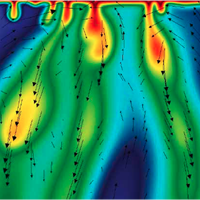
|
CCSE's Porous Media AMR calculations are featured in this
HPCWire story that was picked up from the
LBL article published recently.
"Everybody talks about the weather, but nobody does anything about it." That quote is over a 100 years old, but if you swap in "climate change" for "the weather" you have a pretty good update for the 21st century. And if you've been following the news lately or have just stepped outside, you may have noticed that the climate is getting a little, shall we say, unpredictable...
more
|
|
For the article on which the articles were based, see
G. S. H. Pau, J. B. Bell, K. Pruess, A. S. Almgren, M. J. Lijewski, K. Zhang,
"High resolution simulation and characterization of density-driven flow in CO2 storage in saline aquifers'',
Advances in Water Resources, 33(4):443-455, 2010
|
CCSE Collaborators Featured by Minnesota Supercomputing Institute for Advanced Computational Research -- Research Spotlight
The first stars of the early days of the universe hold the key to understanding the formation of the first heavy elements
and first galaxies. These stars, which were very massive, died as Pair Instability Supernovae (PSNe).
During the
2010 MSI Research Exhibition,
graduate student Ke-Jung (Ken) Chen, a member of
Professor Alexander Heger's research group in the School of Physics and Astronomy, presented a poster concerning
research into the energetics, hydrodynamic instabilities, and nucleosynthesis of PSNs. The simulations for this
research were performed using CASTRO,
a compressible astrophysics code developed in CCSE.
The poster was selected as one of the finalists by the Exhibition judges and an article about this work
will appear in the Spring 2011 MSI Research Bulletin. The image here is from a simulation of a PSN model.
|
|
January 2011 News
|
From a recent
article
in the Berkeley Lab Computing Sciences newsletter ...
Geological models that break the problem into fixed size pieces cannot reveal phenomenon needed to understand
sequestration because they have either insufficient detail or require too much computation to be practical.
"About 100 meters resolution is the best we can do," Pruess says.
|
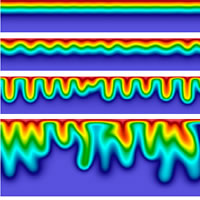
|
Because convection effects start at scales smaller than a millimeter, they are typically invisible to these geological models.
That's why Berkeley Lab's CCSE and Pruess collaborated to develop a new simulation code.
The code combines a computing technique called adaptive mesh refinement (AMR), with high-performance
parallel computing to create high-resolution simulations. The team's simulations were performed at NERSC
using 2 million processor-hours and running on up to 2,048 cores simultaneously on a Cray XT4 system named Franklin.
|
|
Called Porous Media AMR, or PMAMR, the code concentrates computing power on more active areas of a simulation
by breaking it into finer parts (higher resolution), while calculating less active, less critical portions in coarser
parts (lower resolution). The size of the chunks, and thus the resolution, automatically shifts as the model changes,
ensuring the most active, critical processes are also the most highly resolved. This ability to automatically shift focus
makes AMR a powerful tool for modeling phenomena that start small and grow over time, says Pruess.
These three-dimensional simulation snapshots show the interface between sequestered CO2 and brine over time. The sequence, starting at the upper left frame and proceeding counterclockwise, shows a dramatic evolution in
the size of the convection cells with time. Courtesy George Pau.
|

|
The first PMAMR models were of modest size, on the scale of meters. But the eventual goal is to be able to use the
characteristics of an aquifer—such as the size of the pores in the sandstone, the amount of salts in the water, or the
composition of the reservoir rocks—to model a given site and predict how much CO2 it can accommodate.
PMAMR simulations might also be used to help geologists more accurately track and predict the migration of hazardous
wastes underground or to recover more oil from existing wells.
|
|
And the team's three-dimensional simulations could help scientists uncover details not apparent in two-dimensional models.
|
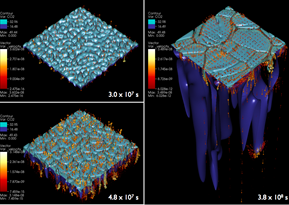
|
The next challenge the team faces involves extending and integrating their models with large-scale models.
"If you look how much CO2 is made by a large coal-fired power plant, and you want to inject all that underground for
30 years, you end up with a CO2 plume on the order of 10km in dimension," says Pruess. This free CO2 will continue to
migrate outward from the injection site and, if the aquifer has a slope, could eventually reach drinking water aquifers
or escape at outcrops hundreds of kilometers away.. "We are very interested in the long-term fate of this thing," says Pruess.
|
|
G. S. H. Pau, J. B. Bell, K. Pruess, A. S. Almgren, M. J. Lijewski, K. Zhang,
"High resolution simulation and characterization of density-driven flow in CO2 storage in saline aquifers'',
Advances in Water Resources, 33(4):443-455, 2010
|
Archive
|
|

 We are currently taking applications for postdocs.
Click the following links to apply:
We are currently taking applications for postdocs.
Click the following links to apply: